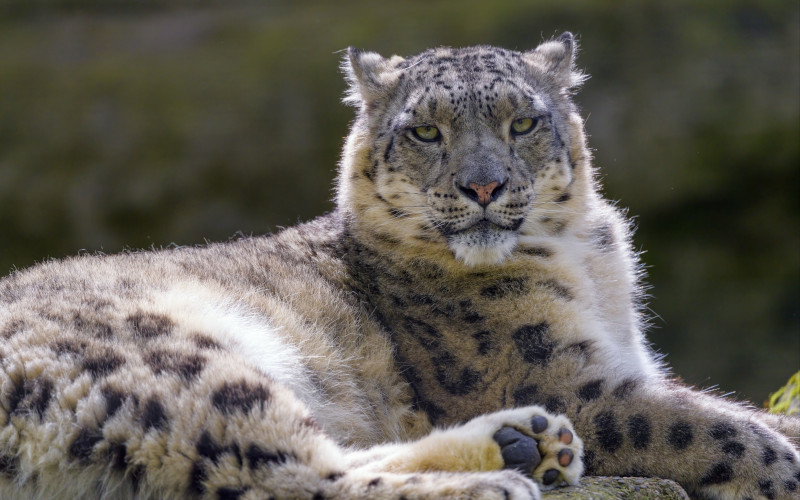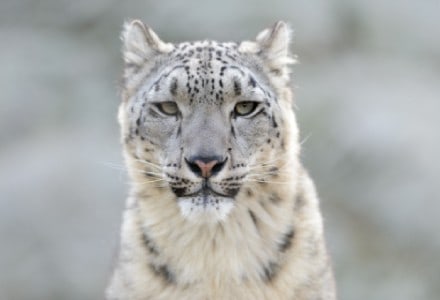
Public Domain Image
Snow Leopard Facts
- Because of its majestic beauty, the gorgeous Snow Leopard presently holds a highly unique status. The stunning creature represents the National Heritage Animal in two countries within its territorial range. As a result, it’s afforded a certain measure of protection.
- The mammal also ranks among the most beautiful of the so-called big cats. It’s also the least aggressive towards humans. These felines reportedly can easily driven away from livestock. The animal even readily abandons its kills if approached by humans.
- Sadly, this remarkable wild feline now finds itself in danger of extinction. The IUCN lists the Snow Leopard as Threatened. Additionally, climate change and habitat loss represent the greatest threats to its continued existence as a species.
Related Articles
Cougar Cheetah Florida Panther
Photographer: Eric Kilby
CC License: http://bit.ly/2xLZ0ap
Snow Leopard Physical Description
Perhaps most notably, the magnificent Snow Leopard differs from related creatures in an unexpected manner. This animal evolved as slightly smaller than other big cats. The body remains stocky in shape, averaging about 50 in (130 cm) in length.
It also achieves a usual weight of about 120 lb (55 kg). That’s significantly less than most big cats. The legs of the feline develop as comparatively short. Furthermore, the feline measures an average length of 24 in (60 cm) at the shoulder.
However, the relatively lush tail develops as quite long, averaging roughly 39 in (100 cm) in length. Furthermore, its evolutionary adaptations include the well-known stocky build, much thicker fur, smaller ears, and wider paws.
The beautiful Snow Leopard also remains capable of leaping as much as 50 ft (15.2 m). Meanwhile, its coloring varies a relatively large degree between individuals. This range generally runs from a smoky gray to a tan color, with the ubiquitous spots.
These patterns provide for excellent camouflage within its endemic habitat. In addition, the eyes of the mammal appear very distinctive, and typically show gray or pale green in color. Occasional individuals are born with a brilliant blue variant.
- Kingdom: Animalia
- Phylum: Chordata
- Class: Mammalia
- Order: Carnivora
- Family: Felidae
- Genus: Panthera
- Species: P. uncia
Snow Leopard Distribution, Habitat, and Ecology
The stunning Snow Leopard evolved as endemic to a specific portion of the globe. More precisely, that consists of Central and Southern Asia. Within that range, it remains restricted to the upper mountain ranges, in Afghanistan, and Pakistan.
The remarkable species commonly inhabits both the alpine and sub-alpine ranges. It also lives at impressive altitudes. These heights average between 9,800 – 14,800 ft (3,000 – 4,500 m). The species of big cat prefers terrain that is rocky or snow-covered.
In addition, the feline has a very distinct time of activity. This active period generally consists of several hours, occurring at or near twilight. The species also evolved as primarily carnivorous and appears to be an excellent hunter.
Further, individuals typically take smaller types of prey, such as rabbits and birds. But, individuals will occasionally take prey several times their own size. This stunning animal also feeds opportunistically, consuming carrion, when necessary.
The Snow Leopard also sets itself apart from others in one more way. It eats a larger percentage of vegetation than any other big cat. The feline leads a primarily solitary life. It usually only groups together to mate, or while a female is rearing her cubs. A typical lifespan is 15-18 years.
Snow Leopard Conservation Efforts
The animal man knows as the Snow Leopard sadly faces the danger of extinction. Exact tallies of its numbers in the wild remain impossible to attain. This lamentable fact holds true given the remoteness of its habitat. Current estimates place its numbers at fewer than 8,700.
Fortunately, though, numerous organizations are now actively working to preserve the fantastic species. In fact, in the year 2013, the governments of 12 of the countries the gorgeous feline inhabits signed the Bishkek Declaration.
Preservation efforts of many kinds remain underway, both large and small in scope, but all are greatly appreciated. The Declaration created numerous protected areas within the range the felines inhabit. To date, a total of 23 of these protected areas exist.
A few of these include Chitral National Park, in Afghanistan, and Tumor Feng Nature Reserve, in China. Yet, more must be done to protect it. Quite sadly, illegal poaching of the Snow Leopard still occurs, as well as a threat from habitat loss.

